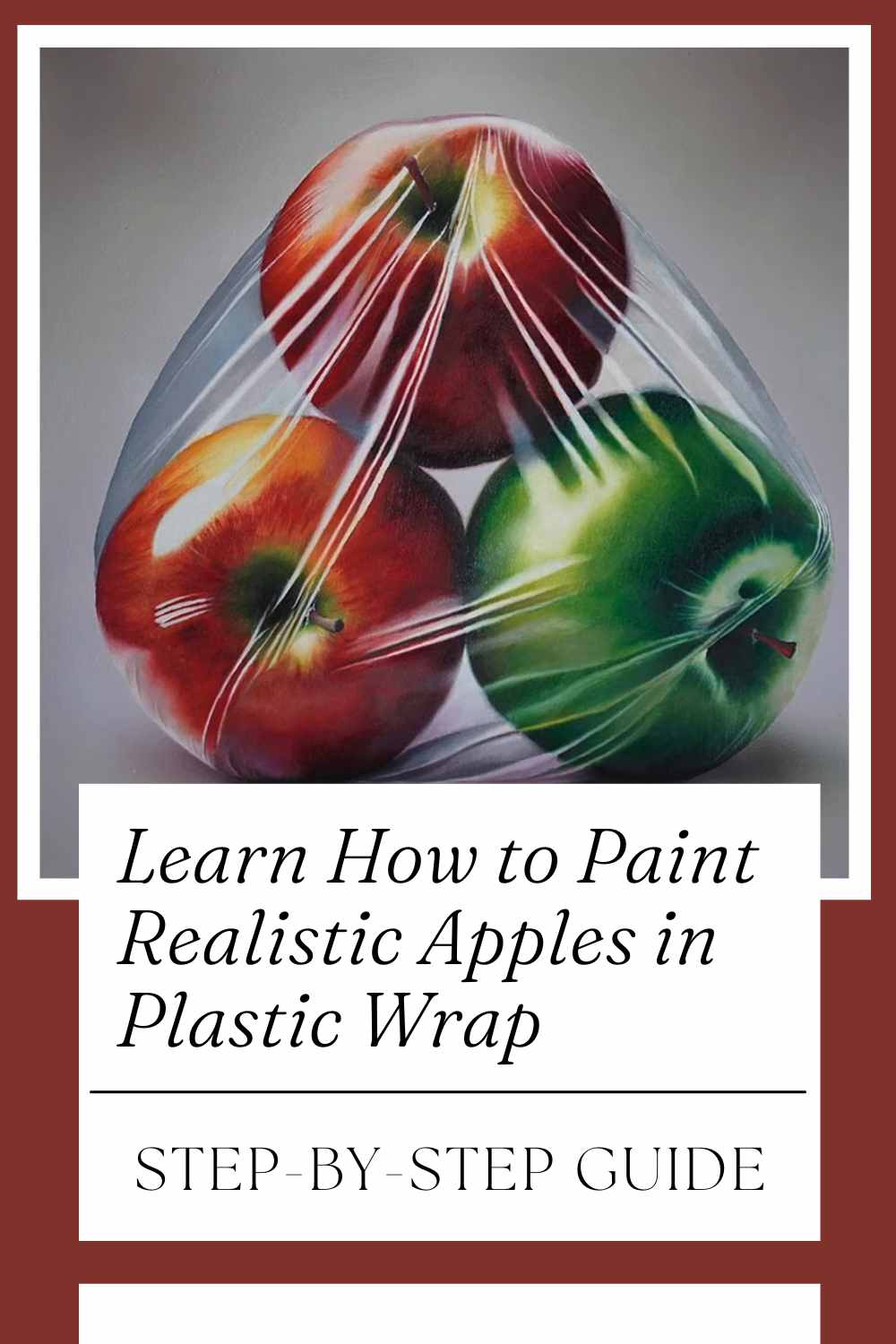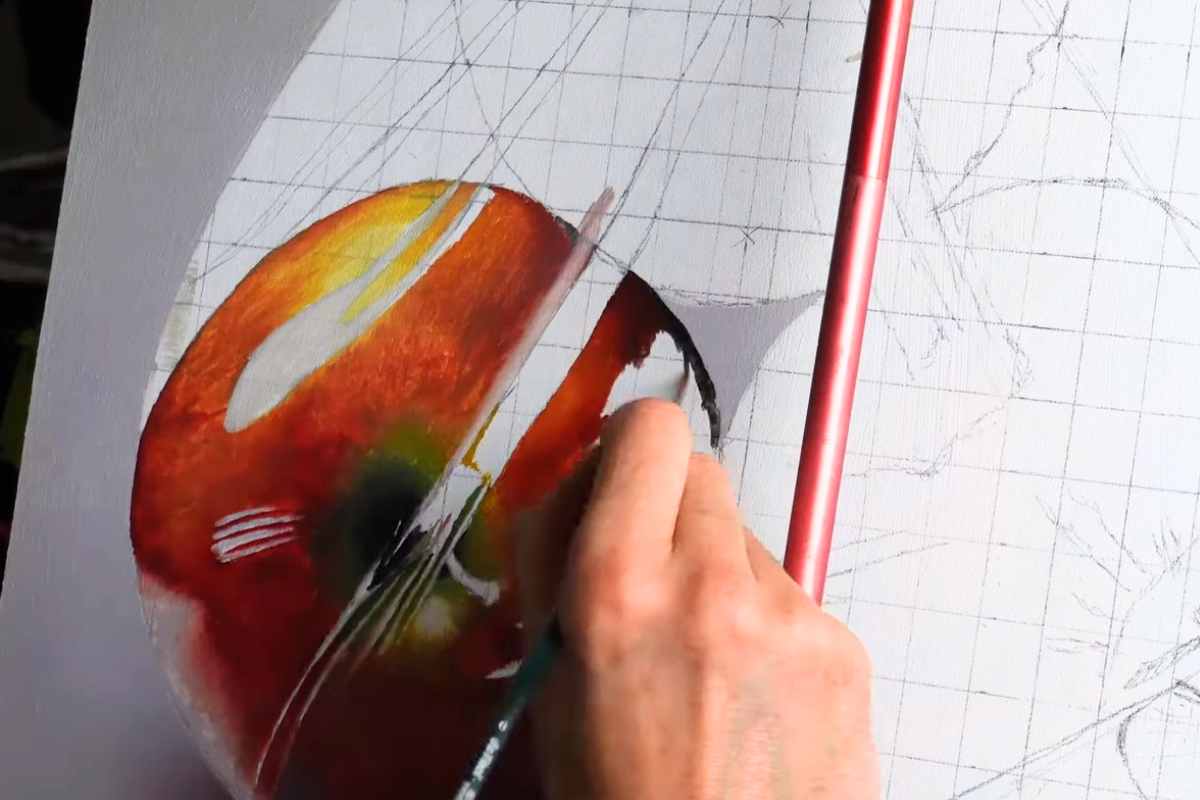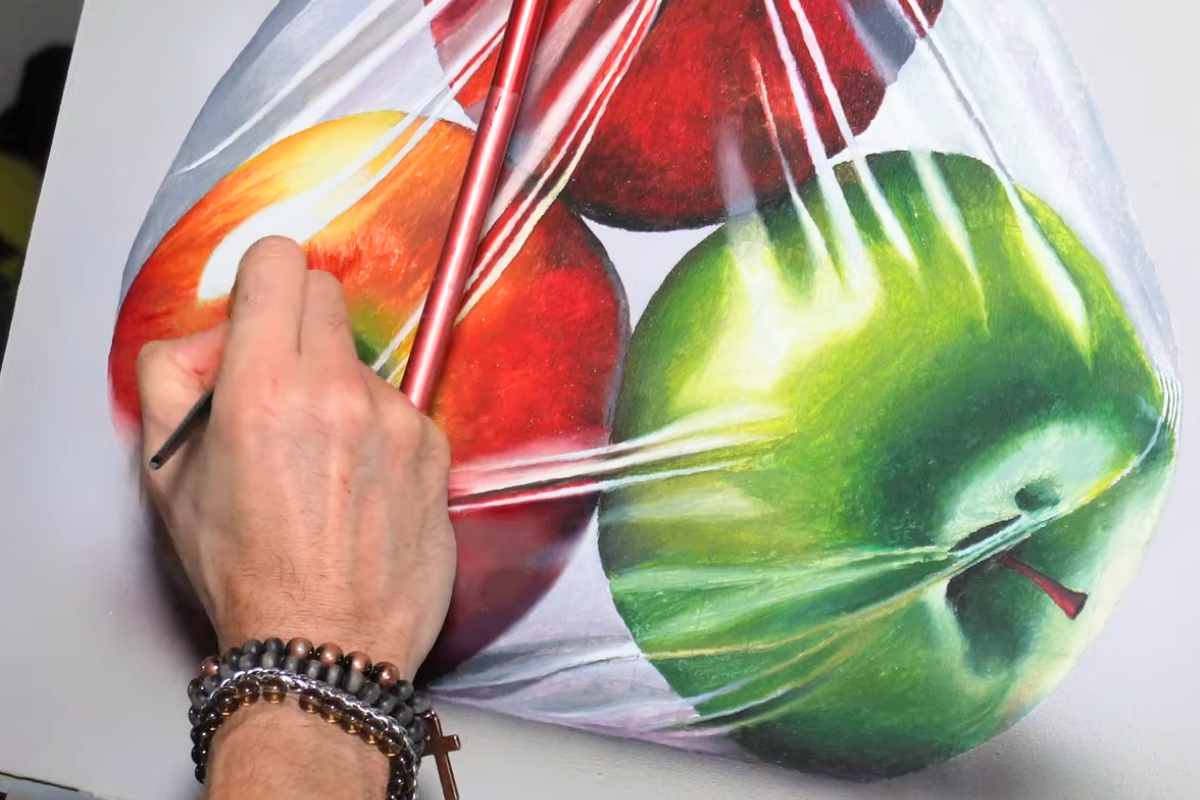Learn How to Paint Realistic Apples in Plastic Wrap with Oil Paints

Oil painting is a versatile medium that allows artists to capture stunning details and textures. One fascinating subject to explore in oil painting is apples in plastic, a concept that challenges the artist’s ability to create depth, texture, and a realistic effect.
This subject involves not just painting the apples but also accurately depicting the plastic wrap around them, creating a dramatic contrast between the smooth, shiny plastic and the natural, textured surface of the apples.
In this article, we will dive into the techniques and approaches used to achieve a realistic oil painting of apples wrapped in plastic, all while using techniques covered in a video tutorial.
Why Paint Apples in Plastic?
At first glance, painting apples in plastic might seem like a simple subject, but it offers a fantastic opportunity to practice some advanced painting techniques.
The reflective nature of plastic combined with the smooth, shiny surface of the apples can help artists master the use of light and shadow, texture, and the depiction of reflective surfaces.
Playing with Contrast and Detail
The combination of a vibrant apple with its natural smoothness and the translucent plastic creates an interesting contrast. The shine of the plastic wrap and the dull matte finish of the apples provide an opportunity for artists to experiment with texture and depth.
The light reflections on the plastic wrap give the painting a feeling of dimensionality that is visually intriguing.
Enhancing Color and Texture Skills
Painting objects like apples in plastic not only helps hone color mixing but also teaches how to achieve realistic textures.
The color variations in the apples and the way light plays on them provide a dynamic interplay of tones, shadows, and highlights, offering a great lesson in layering oil paints.
Mastering Realism in Oil Painting
Achieving a realistic oil painting of apples in plastic requires careful attention to detail. One of the most important techniques in oil painting is the use of layering and glazing.
The glaze technique involves applying a thin layer of paint over dried layers to deepen shadows and enhance light. Here’s how it works for this subject:
Layering Paint for Depth
Start with a base layer for both the apples and the plastic wrap. The apples should begin with a light underpainting, where you map out their shape and basic color.
You can start with midtones, gradually adding darker shadows and brighter highlights as the paint dries.
For the plastic wrap, the key challenge lies in creating a transparent effect. By layering thin washes of paint, you’ll achieve the subtle sheen that plastic reflects. The reflections of the apples on the plastic wrap are another layer of challenge, but they are essential to bringing the painting to life.
Achieving Realistic Highlights
One of the most difficult aspects of painting apples in plastic is the shiny reflective surface of the plastic. To capture this, it’s essential to pay attention to the subtle light reflections on the wrap and how they interact with the apple surface.
When painting reflections, you will need to carefully observe the environmental light sources and how they bounce off the surface of the plastic. This means adding highlights with lighter shades, creating a shiny, wet look.
Color Harmony and Realistic Tones
The realistic portrayal of the apple’s green and red tones requires skillful blending of colors. You will likely use several shades of yellow, red, and green, adjusting them for the shadowed areas and light reflections.
This harmonious mix of colors helps bring the apple’s texture and depth to life, making it appear three-dimensional and fresh. Similarly, the plastic wrap, though subtle in color, will benefit from shades of white, gray, and touches of blue to give it a realistic sheen and depth.
Challenges in Painting Realistic Apples in Plastic
While the concept is visually striking, painting apples in plastic presents several challenges. Here are the main areas where artists typically struggle:
Capturing the Translucency of Plastic
Plastic wrap is transparent, which means it distorts and bends the light in interesting ways. When painting this material, you must create a sense of depth and clarity while still capturing the soft nature of the plastic.
One technique is to use glazing to allow the underlying layers of paint to show through subtly.
Reflection of Light on Both Surfaces
The reflective nature of the plastic and the glossy surface of the apples can make it difficult to depict the two different textures in a realistic manner.
While the apples have a smooth surface, the plastic behaves more like a mirror, reflecting not just the apples but the surrounding light sources. Understanding how light behaves across both surfaces requires close attention to light, reflection, and highlights.
Maintaining the Apple’s Texture
A major challenge is ensuring the texture of the apple is still visible despite the overlay of plastic. The plastic wrap can obscure the natural texture of the apples, so it’s essential to paint them with just the right amount of detail to ensure they still look realistic underneath the plastic.
Pay attention to brushstroke technique—a gentle touch will create smooth gradients on the apple's surface, while precise, small strokes will help define areas like the apple’s stem or blemishes.
Tips for Success in Painting Apples in Plastic
If you're aiming for a realistic oil painting of apples in plastic, here are a few tips to help you succeed:
Study Light and Reflection Carefully
Spend time studying how light interacts with objects and their surroundings. Observe the reflections in everyday objects, such as plastic-wrapped fruit or shiny surfaces, to understand how the light bounces and reflects.
Practice Layering and Glazing
Layering is key to achieving depth in oil paintings, especially when working with reflective or translucent surfaces like plastic. Glazing over dried layers helps build up the shine and depth you need to make both the apple and plastic look realistic.
Use Fine Brushes for Details
When painting the finer details, such as the water droplets on the apples or the translucent effect of plastic wrap, use fine-tipped brushes for precision. Small brushes will help you capture the delicate reflections and the glossy, almost wet look of the plastic.
Conclusion: The Art of Painting Apples in Plastic
Painting apples in plastic in oils is an excellent way to hone your skills in light, shadow, and texture. While it’s a challenging subject, the resulting painting will help you improve your technical abilities, making you a more confident and capable artist.
Through careful observation, layering, and attention to detail, you can create a stunningly realistic painting that showcases the beauty of both the apples and the plastic wrapping.
By following the tips and techniques outlined in this tutorial, you can transform simple fruit into a vibrant, lifelike composition. This subject not only challenges your painting skills but also teaches you how to capture the subtleties of everyday objects in a way that feels both artistic and real.
We thank Marcel Ruben for the images.
Enjoy The Video Tutorial

Source: Marcel Ruben
Did you find this post useful or inspiring? Save THIS PIN to your Art Board on Pinterest! 😊

Last update on 2025-11-27 / Affiliate links / Images from Amazon Product Advertising API




Discover More Artistic Inspiration